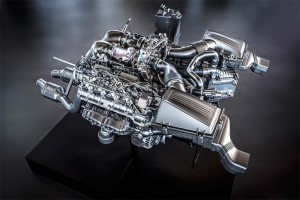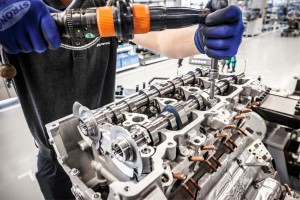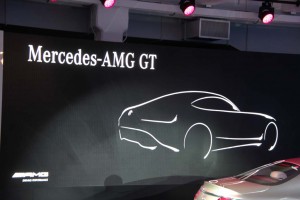With the unveiling of its all-new 4.0-liter V-8, Mercedes-Benz joins a growing trend in the automotive performance market. Smaller, it seems, is better as performance and mileage requirements collide.
Due to make its debut under the hood of the planned Mercedes-Benz AMG GT, the new twin-turbo V-8 will deliver the sort of numbers that would traditionally require a far bigger engine – along with the fuel economy traditionally not possible in a high-performance sports car.
A growing number of makers are opting for features like turbocharging, and even hybridization, to generate more power out of smaller engines. And as ever-tougher fuel economy and emissions standards go into place around the world, the trend is only likely to accelerate, according to industry planners and engineers.
The new V-8, declares Christian Enderle, head of engine and powertrain development for Mercedes-AMG, says the engine, “represents the next step in efficiency.”
The new AMG V-8 pumps out a healthy 510 horsepower and 479 pound-feet of torque. Measured another way, that’s about 128 hp per liter, a huge figure compared to traditional high-performance engines.
(Click Here for our review of the 707-hp Dodge Challenger SRT Hellcat.)
The biturbo design is one of the engineering tricks helping the new engine get there. Their turbines can spin up to 186,000 RPMs, and a special cooling system ensures both maximum efficiency and reliability.
The V-8 itself uses an aluminum crankcase and what is known as Nanoslide technology for cylinder bore surfaces that makes them twice as hard as traditional cast-iron linings. But forged aluminum pistons and low-friction piston rings reduce both oil and fuel consumption.
(Click Here for a first look at the new Mercedes-Benz S65 AMG Coupe.)
The engine uses an unusual design layout, with the twin turbos mounted inside the V of the two banks of cylinder. The layout, AMG claims, has several benefits. It reduces dreaded turbo lag, reduces emissions – and it means a more compact layout for a cramped engine compartment. That goal is further enhanced by the use of dry sump lubrication.
Overall, the new V-8 weighs just 458 pounds, which appears to make it the lightest powerplant in its competitive segment.
Like a growing number of engines, the new AMG V-8 will be paired with an active sports exhaust system using variable flaps that allow the driver to choose between a quieter, more relaxing engine note or a more resonant, “emotive” roar, as Mercedes puts it.
The new V-8 is likely to see widespread use in the AMG line-up in the years ahead. But expect to see it first appear in the new Mercedes-Benz AMG GT that was teased during a preview at this year’s New York Auto Show.
Intended to challenge the upper range of the Porsche 911 line, the new Mercedes sports car reportedly will get a private, online unveiling on September 9, with its public debut formally scheduled for the Paris Motor Show in October.
(Porsche spices up the Cayenne for 2015. Click Here for a closer look.)




Probably a very cool new engine but as other makers have found out, placing turbos in the V section usually leads to premature failures as it becomes a heat capsule. Fuel pumps and other devices located in the V section tend also to have issues. In the end the customer pays when these engines have expensive issues 50K miles down the road.